Pizza (especially sourdough pizza) might be my favorite food—don't tell sourdough bread that, though. I spent many childhood days in my dad's Italian restaurant watching him and other pizzaiolo make pizzas for customers streaming through the doors.
While I know their pizza wasn't naturally leavened, it sure was delicious, but I am confident you won't want anything else once you try a sourdough pizza. It has an incredible flavor, improved digestibility, and I find an even better texture.
What is Sourdough Pizza?
Sourdough pizza is made with naturally fermented dough using a sourdough starter. Instead of using commercial or instant yeast to leaven and flavor the dough, the suitable (and beneficial) bacteria and wild yeasts in a sourdough starter are responsible for creating flavor and making the sourdough pizza dough rise.

Is Sourdough Good for Pizza?
Yes, sourdough (natural leavening) can be used to make pizza. I find sourdough pizza is more flavorful, easier to digest (thanks to the lengthy fermentation process), and has an improved, tenderer texture. Additionally, if you maintain a sourdough starter, it's easy to use that to quickly make a batch of pizza dough using some of your starter (essentially sourdough starter discard).
Further, pizza was likely invented long before the creation of instant or commercial yeast; this means the original pizza, in whatever form it existed, must have been sourdough.
Why I Like Sourdough Pizza
- Increased flavor
- Increased digestibility
- Tender texture
- Easy to use sourdough discard to make the dough
Does Sourdough Pizza Taste Sour?
A properly fermented and balanced (in terms of yeast and bacteria) sourdough pizza dough isn't overly sour. The organic acids produced as a byproduct of natural fermentation increase the depth of flavor—sourness—due to the longer fermentation time. However, the sourness isn't sharp or off-putting; it's complex and complementary.
If your sourdough pizza is too sour, try reducing the total fermentation time, skipping or shortening any time the dough is left in the refrigerator.
To add more sourness to your sourdough pizza, increase the total fermentation time. One way is to place the dough in the refrigerator during bulk fermentation as I do with my home oven pizza dough.
How to Make Sourdough Pizza from Scratch
The steps to making sourdough pizza are similar to bread, though the result couldn't be more different.

To seed fermentation, I don't always create a preferment when making pizza dough; sometimes, I'll just use some of my sourdough starter (more on that in a moment).
Concerning dough strength, I find pizza dough likes a strong mix, and if I'm not using the slap-and-fold kneading technique, I'll mix in a spiral dough mixer. No additional strengthening during bulk fermentation is necessary if the dough is mixed to a strong state (also known as full development).
Bulk fermentation, or first rise, is usually shorter than my bread dough, which can be done partly in the refrigerator. If necessary, I might give the dough one set of stretches and folds during bulk fermentation to add strength to the dough.
After dividing and balling the dough, I usually like to retard it in the refrigerator to increase the flavor and make scheduling easier.
And finally, after proofing, the dough is stretched to make the pizza crust, topped, and cooked.
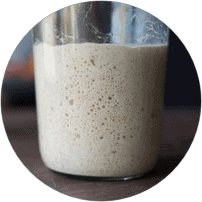
How Much Starter Do I Need for Pizza Dough?
The amount of sourdough starter you need to make pizza dough can vary based on the flour used and the fermentation schedule. Typically, I like to have between 10 to 20% sourdough starter in my pizza dough.
Alternatively, in some pizza recipes (like my wood-fired sourdough pizza dough), I like to make a dedicated levain instead of using my sourdough starter. Usually, this is for scheduling purposes, but it can also help skew the balance of bacteria and yeast toward one or the other. For instance, I might make a fast-ripening levain to increase yeast population with respect to bacteria for more rise and a lighter dough texture.
But at the end of the day, a sourdough starter and levain are the same.
Can I Put My Pizza Dough in the Refrigerator?
Yes, you can put your pizza dough in the refrigerator (also called retarding). Typically, I like to retard my pizza dough in the refrigerator either when the dough is in bulk fermentation (and in one large mass) or after the dough has been divided and shaped into small balls.
It's possible to also retard the dough in bulk fermentation and after balling.
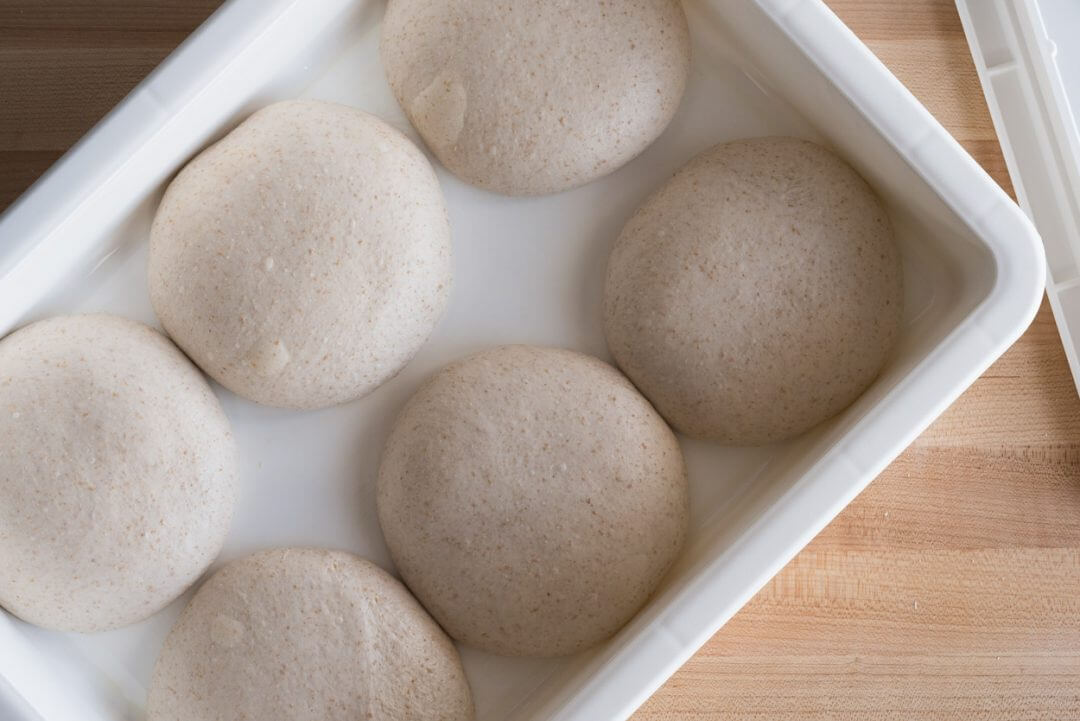
Generally, the longer sourdough pizza dough is left to ferment, the more flavor the dough will have after cooking. However, there is a point of diminishing returns as the dough will eventually begin to break down from too much organic acid production, potentially making it sticky and difficult to stretch.
How Do You Ball Sourdough Pizza Dough?
There's no traditional preshaping step when making pizza dough. Instead, after dividing the dough into pieces, where each will eventually be its own pizza, the pieces are shaped into tight balls before proofing.
And there's a very good reason pizza dough is shaped into balls with a uniform outside skin and tight seam on the bottom.
A smooth and seamless round is much easier to shape into a final pizza crust that's a perfect circle.
As the dough proofs, the smooth dough ball slowly relaxes and spreads outward in a uniform circle. A smooth and seamless round is much easier to shape into a final pizza crust that's a perfect circle.
See my in-depth guide to balling pizza dough →
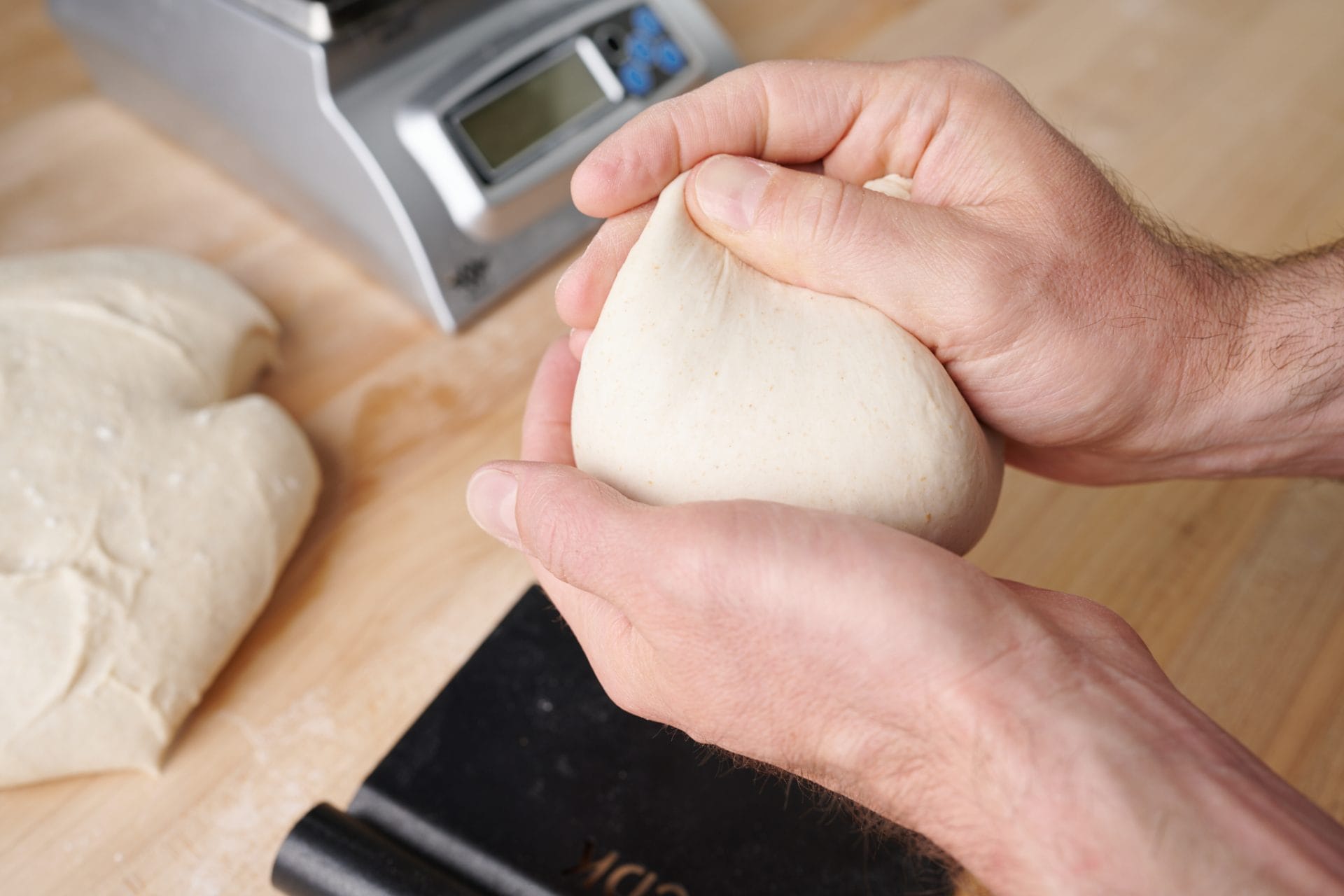
How Do You Stretch Sourdough Pizza Dough?
Stretching pizza dough is the process of taking a shaped dough ball and stretching it out into a large circle that's then topped with sauce and other toppings such as cheese and then cooked. There are many ways to stretch pizza dough, from pressing it out with your hands on the work surface, slapping the dough out to shape (typical with Neapolitan style pizza dough), to stretching it in the air with the backs of your hands.
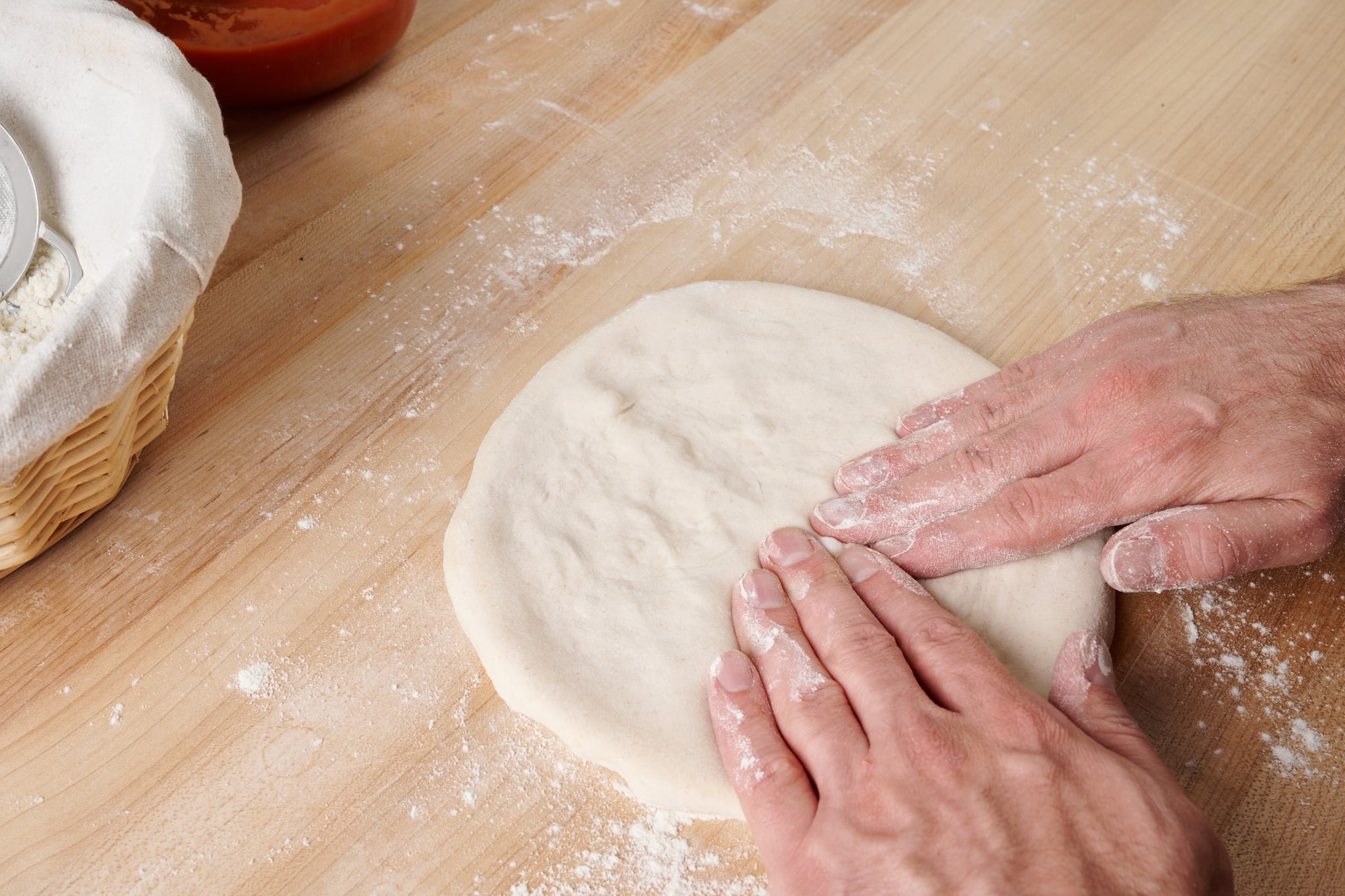
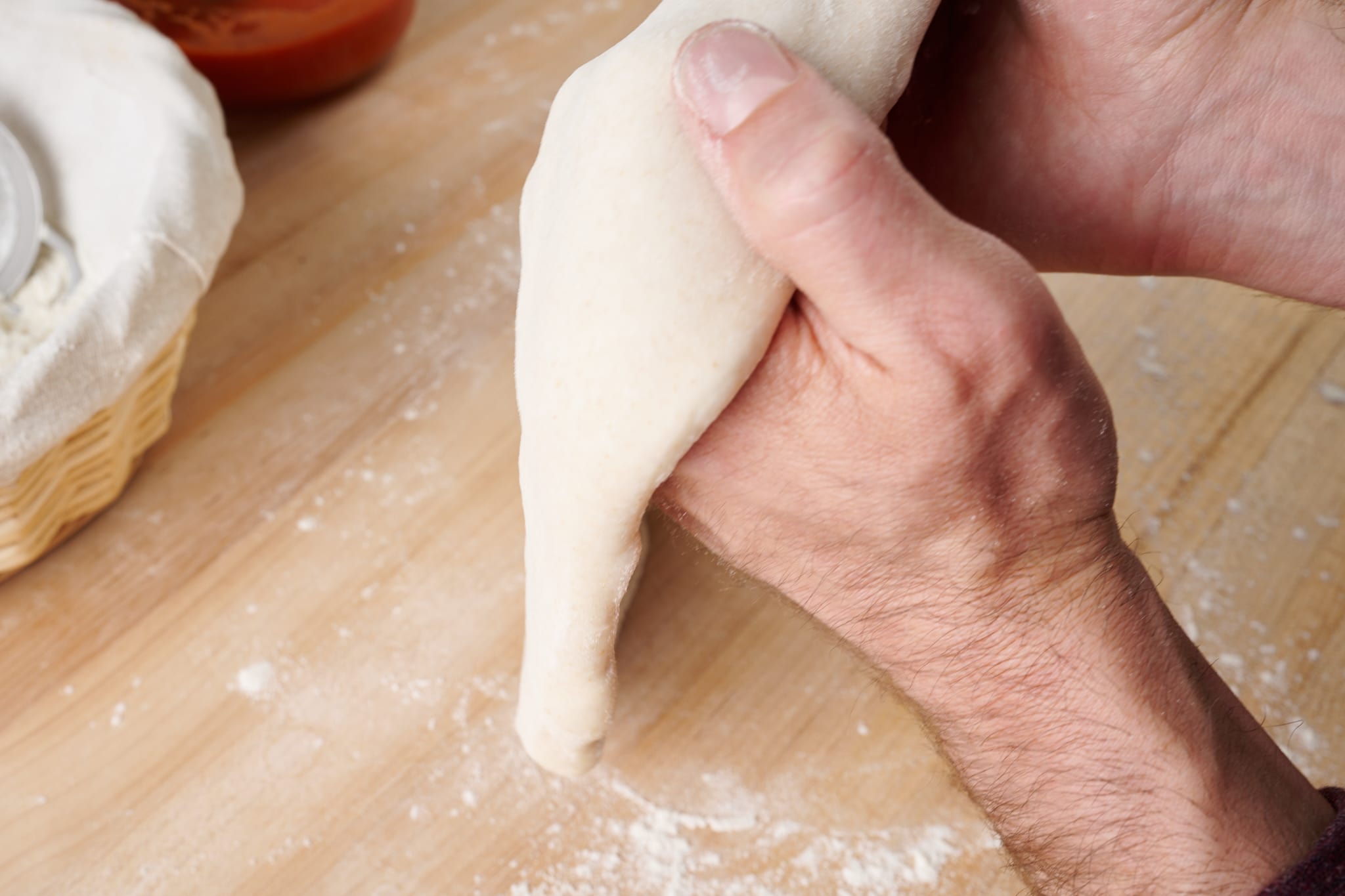
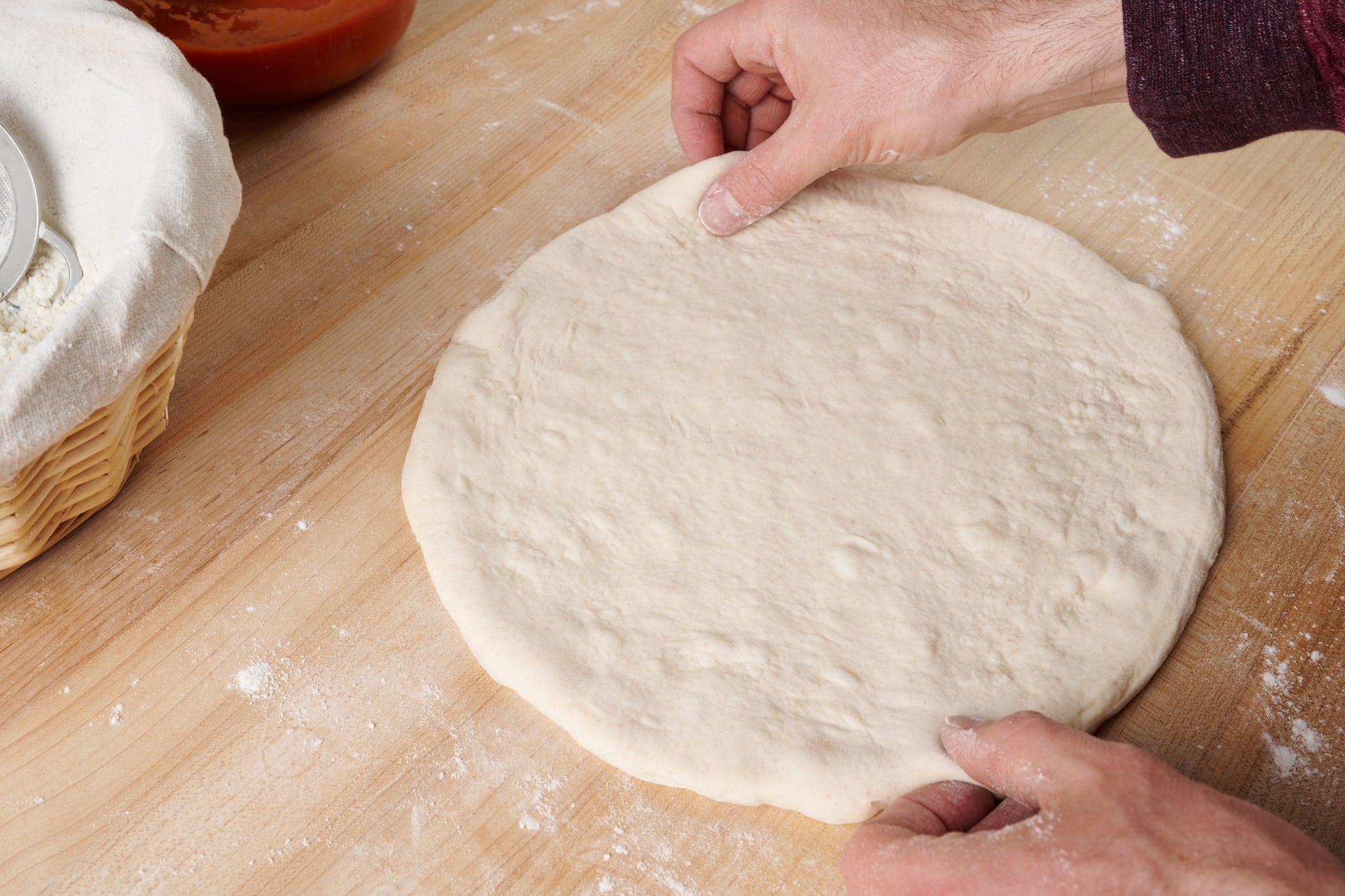
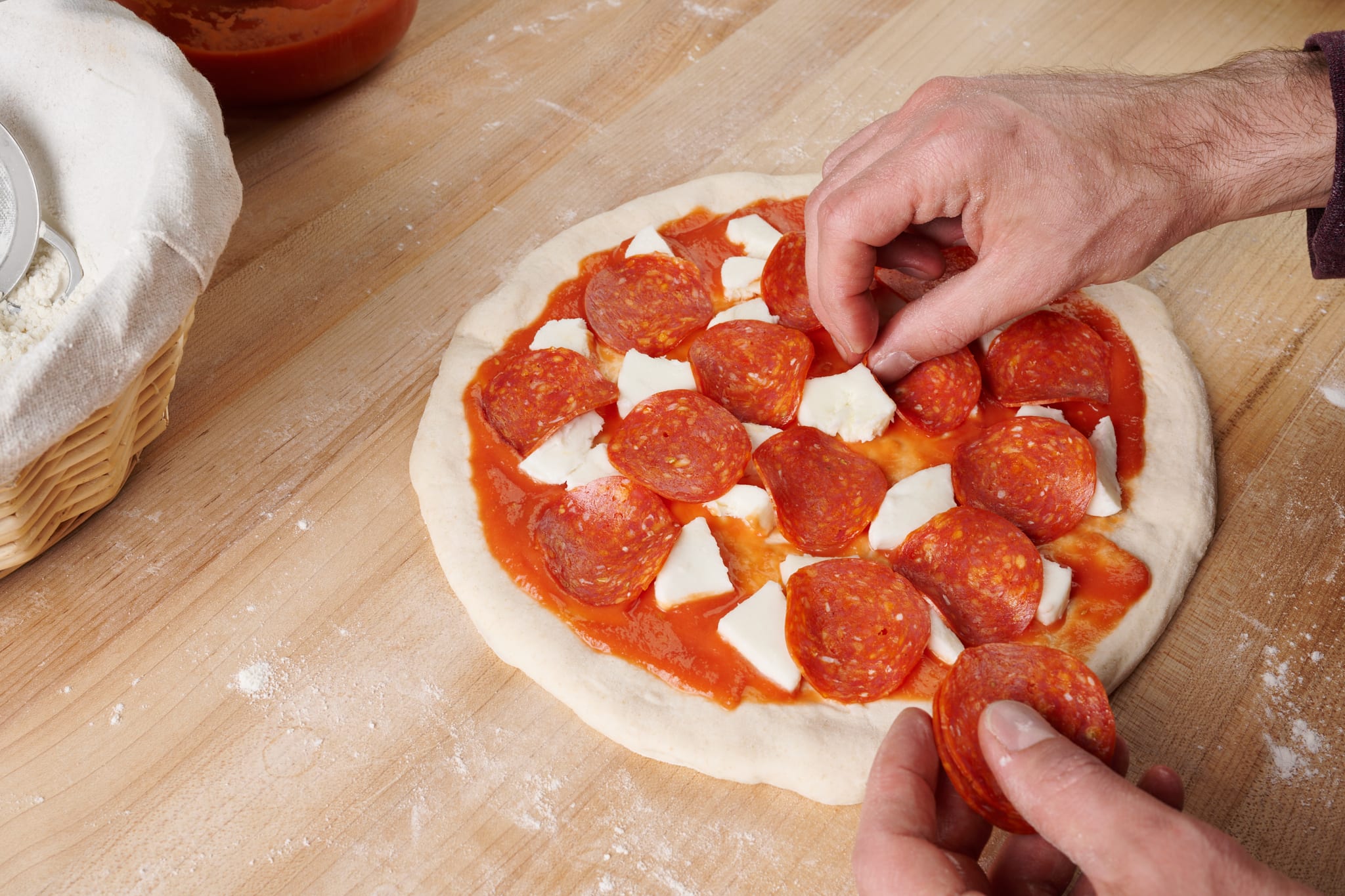
When stretching pizza dough, I first press it out with my hands shaped like an inverted “V,” then drape the dough over my knuckles and gently stretch it out into a large circle. I like this method because it's not overly aggressive and results in a pizza with a tall and open rim (cornicione).
See my guide to balling and stretching pizza dough for a deeper look at these steps of the process →
What Temperature Do You Cook Sourdough Pizza?
Generally, the longer you cook your pizza dough, the more crisp and sturdy the crust will become. I prefer a sturdier pizza than a super-soft Neapolitan-style pizza; to achieve this, I cook my pizza at a lower temperature for longer. With wood-fired pizza, I like to cook at around 600°F (315°C) and in a home oven at around 550°F (290°C).
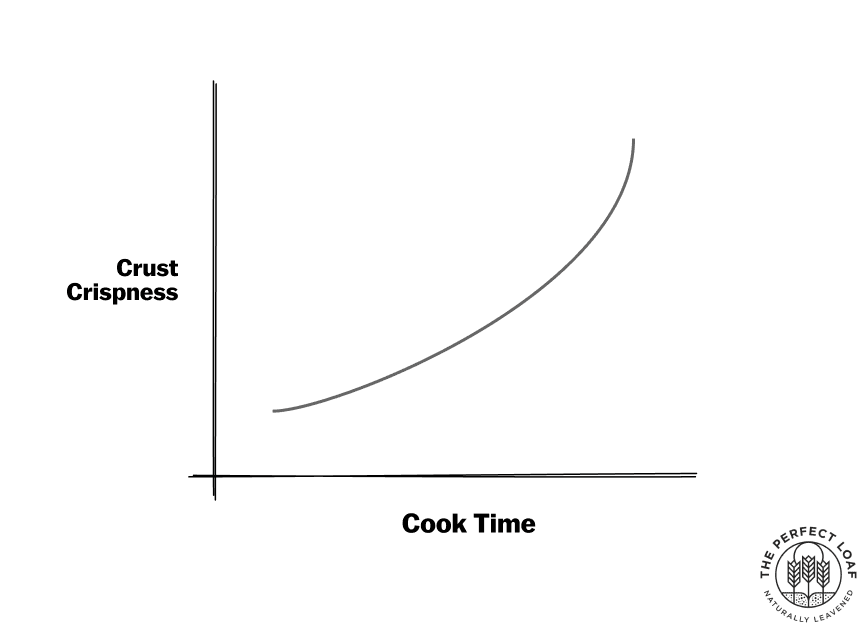
The following are approximate ranges for pizza dough cooking temperatures to get a different style crust and texture.
| Pizza Style | Temperature |
|---|---|
| Neapolitan style pizza | 800 to 900°F (425 to 480°C) |
| New York-style pizza | 600 to 700°F (315 to 370°C) |
| Home oven / NY-style pizza | 500 to 550°F (260 to 270°C) |
What Flour Is Best For Pizza Dough?
Many flours are suited for making pizza, from all-purpose flour to type 00 flour to even whole wheat flour. I prefer using type 00 (Tipo 00), an Italian classification for white flour with very low extraction and fine granularity.
Caputo 00 Pizzaria flour in the blue bag is an excellent choice for type 00 flour.
I've also made incredibly delicious pizza using a high extraction type-85 flour. I love this flour because it's higher protein than all-purpose, which makes for a strong and easy-to-handle dough, but it also has increased flavor thanks to the additional bran and germ in the flour.
My Favorite Sourdough Pizza Tools
Having the right tools for making pizza is half the battle. Just a few items in your home kitchen—like a pizza stone, at the very least—will mean pizza with the proper crust, texture, and flavor.
- Pizza dough proofing trays. These rectangular bins hold up to 6 pizzas and fit in the home refrigerator.
- A nonstick pizza peel. I prefer a wooden peel, but they are large and heavy; this pressed, natural board is nonstick and mimics wood.
- A baking steel. These are super efficient at transferring and retaining heat.
- A pizza stone. Even though I use a baking steel, I also have a stone which is great for pizza and bread.
- A sturdy pizza wheel. I use this heavy-duty pizza wheel to cut every pizza I pull from my oven.
- Pizza cooking ovens: I love my Ooni Koda 16, which gets super hot and cooks pizza in minutes.
- Metal pizza trays. I have six of these and use them to hold my cooked pizza; they're also great for serving!
Sourdough Pizza Dough Recipes
Pizza for the home oven
This is the best sourdough pizza recipe for the home oven. The dough is easy to handle, resulting in a pizza with a chewy crust and a tall rise. Perfect for any toppings!
What I love about this recipe
- Designed to create a chewy crust
- The perfect pizza dough to cook at high temperatures in a home oven
- A flexible pizza dough that can be kept in the refrigerator for up to 72 hours
- Can make a same-day sourdough pizza crust
See my sourdough pizza dough recipe for the home oven →
Sourdough Pizza In a Pan (Pizza al Taglio)
Pizza al taglio, pizza in teglia, or pizza by the slice, is the most laid-back way to make delicious sourdough pizza at home. There's no complicated stretching process and transferring of the dough, just put it in the pan, and it's ready to go. I love this pizza topped with just about anything!
What I Love About This Recipe
- It's so easy! No complicated shaping is needed; just stretch the dough to fit the pan
- Pizza in a pan can serve many people easily
- You can have many toppings without worrying about transferring the pizza to the oven
See my sourdough pizza al taglio recipe →
Sourdough Pizza In a Wood-Fired Oven

This pizza dough is designed to work specifically in a high-heat oven. I use a Fontana Forni wood-burning oven, but the dough works fantastic in an Ooni gas-powered oven or even a Roccbox.
What I Love About This Recipe
- Ample flavor thanks to overnight fermentation
- This moderate hydration pizza dough is easy to ball and stretch
- This dough results in a pizza with a crispy crust if cooked at a lower temperature or a soft crust if cooked at high heat
See my wood-fired sourdough pizza recipe →
Whole Wheat Sourdough Pizza
This is a sourdough pizza dough with a higher percentage of whole wheat for a more robust flavor and increased nutrition. This dough goes well with hearty toppings like broccoli, artichokes, sardines, and more.
What I Love About This Recipe
- Increased nutrition from more whole grains
- A crispy and sturdy crust
See my whole wheat sourdough pizza dough recipe →
More Sourdough Pizza Recipes
Sourdough Pizza FAQs
Why is my sourdough pizza crust tough?
The longer you cook your pizza, the tougher the crust will become. If you want to make it less tough, try cooking the pizza for less time at a higher temperature. Conversely, to make your pizza crust tougher, cook it for a longer time at a lower temperature.
Why is my sourdough pizza crust chewy?
I find pizza crust is chewier if it's made with a high percentage of high-protein flour (13% protein or higher). Additionally, it can help if the dough's hydration is low to moderate.
Can pizza dough be sour?
Using natural fermentation and your sourdough starter, it's possible to increase the sourness in your pizza dough by allowing it to ferment longer. Typically, this would mean cold fermentation in the refrigerator.
What is pizza cornicione?

Cornicione is an Italian word for the rim around the pizza. It's the part you grab with your hands and is usually taller than the rest of the pizza. Typically, Neapolitan-style pizza has a very pronounced cornicione that is open and airy.
Is Neapolitan pizza sourdough?
Not necessarily. Neapolitan pizza is characterized by short, high-heat cooking (over 800°F) and results in a pizza with a very soft crust. This dough can be made with sourdough fermentation, instant or commercial yeast, or even a combination.
At what stage do you freeze sourdough pizza dough?
You can freeze sourdough pizza dough when it's shaped into balls. Freeze each piece of dough individually in a sealed container (like a 4-cup glass bowl). To thaw, place the container to the refrigerator overnight, then take the dough ball out to finish proofing on the counter until relaxed, puffy, and soft to the touch.
What's Next?
If you love sourdough pizza, you'll love its cousin, sourdough focaccia. Focaccia is kind of like pizza, in a way, though it typically has more minimal toppings. In some cases, like with my sourdough focaccia Pugliese, the dough has added potato for more chewiness and tenderness.




